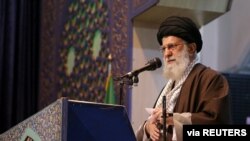Iranian state media have given a distorted view of Western news coverage of a rare public sermon by Iran’s supreme leader, ignoring how Western outlets highlighted perceived shortcomings in his responses to domestic problems.
Ayatollah Ali Khamenei led Friday prayers in Tehran for the first time since 2012, giving a sermon at the capital’s Grand Mosque. The longtime supreme leader has limited such public sermons to times of national crisis in the past.
In his speech, Khamenei harshly criticized the United States and its European allies Britain, France and Germany. He singled out American leaders as “clowns” for professing to stand with Iran’s people while in practice seeking to “stab” Iranians in the back with a “poisoned dagger.”
Khamenei’s speech came two weeks after the U.S. carried out what it called a self-defensive strike that killed his top general, Qassem Soleimani, at Baghdad airport. In his remarks, Khamenei accused the U.S. of engaging in a “terrorist” act by killing Soleimani, who led Iran’s elite Quds Force and whom the U.S. had designated as the head of a terrorist organization that killed hundreds of U.S. troops in Iraq and directed proxy militias to fight U.S. allies in the region.
The Iranian supreme leader also denounced Britain, France and Germany as U.S. lackeys after they decided this week to trigger a dispute resolution mechanism in their 2015 nuclear deal with Iran, a potential step toward joining the U.S. in re-imposing economic sanctions on Tehran.
Khamenei expressed sorrow over the Jan. 8 shooting down of a Ukrainian passenger plane by Iranian forces that mistook it for an enemy threat shortly after it took off from Tehran. Hours earlier, his forces had fired missiles at U.S. troops in Iraq in retaliation for the Soleimani killing and had braced themselves for a U.S. counterattack. No U.S. forces were killed in the Iranian missile strike, however, and Washington did not hit back.
For three days after the plane crashed, killing all 176 people on board, Iranian officials insisted it was not their fault despite Western media and officials citing intelligence sources as saying Iranian missile fire downed the aircraft. Officials belatedly acknowledged that their denials of responsibility were false on Saturday, angering hundreds of Iranians who joined four days of anti-government protests in Tehran and other cities.
“The plane crash was a bitter tragedy that burned through our heart,” Khamenei said in his sermon. However, he made no apology for his government’s initial false statements about the crash and criticized those who joined the anti-government protests as unrepresentative of the Iranian people.
Prominent Western news agencies had extensive coverage of Khamenei’s rare public sermon.
Iranian state media outlets Fars News Agency and ISNA published summaries of those Western news reports, highlighting their references to Khamenei’s strong denunciations of the U.S. and European powers. Fars and ISNA also cited the Western news agencies as noting the large size of Khamenei’s audience, with thousands of people cramming into the mosque for the sermon.
A VOA Persian review of Khamenei sermon articles by the eight Western news agencies cited by Fars and ISNA, though, found that the two Iranian state media outlets ignored several key elements of the Western news coverage.
In one example, Fars avoided mentioning that a Reuters report said Khamenei stopped short of a direct apology for the plane disaster. “On social media, some Iranians reacted angrily” to the lack of an apology, the report said.
In another example, ISNA made no mention of the New York Times reporting that Khamenei “offered only scant condolences” to the families who lost victims in the plane crash and dismissed the anti-government protesters as “stooges of the United States.” The New York Times article also noted that Iran “choreographed” the Friday sermon by busing in schoolchildren, civil servants and worshippers from neighboring provinces “to present an image of power and unity.”
“When it comes to reporting an important speech by the supreme leader, it is no surprise to see there has been an attempt to pick and choose bits of coverage in international media that are either positive or neutral and leave out the negative bits,” said BBC Monitoring journalist Shayan Sardarizadeh, a former Iranian state media employee, in a message to VOA Persian.
“Reports about the views and speeches of Khamenei are almost always entirely supportive,” Sardarizadeh said. “It would be highly unusual to see state media highlight any criticism of the supreme leader even in normal times, let alone now. But Khamenei is one of the few individuals about whom all media sources in Iran tend to be highly cautious and selective in their reporting.”
This article originated in VOA’s Persian Service. It was produced in collaboration with VOA’s Extremism Watch Desk.






